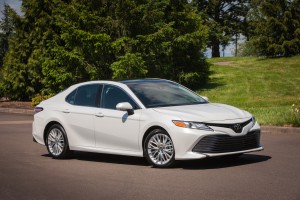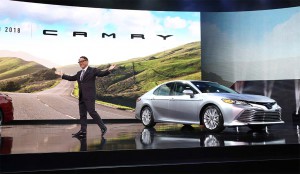
Toyota posted an 11% increase in net earnings for the company's first quarter, beating analysts' forecasts.
Toyota Motor Corp. delivered an 11% jump in net earnings on Friday, though the maker said its operating profit tripped by roughly the same percentage during the first quarter of its fiscal year.
The numbers were better than industry analysts had predicted, nonetheless, and the Japanese giant raised by 16% its forecast for net income during the fiscal year ending next March 31, in part due to expectations for a weaker yen.
Toyota’s financial news was all but drowned out, however, by the maker’s confirmation that it will take an equity stake in smaller Japanese maker Mazda Motors Corp. The two companies also are expected to launch a new joint venture to produce electric vehicles while setting up a U.S. assembly plant that will cost $1.6 billion and employ as many as 4,000 workers after it goes into operation in 2021.
Toyota will also take a 5% equity stake in Mazda as part of the deal, and Mazda will do the same with Toyota, although the size of the holding is unclear.
(Toyota pairing with Mazda on EV project, $1.6b U.S. car plant. Click Here for the story.)
Toyota said its first fiscal quarter net profit jumped to 613.0 billion yen, or $5.522 billion, from 552.4 billion yen, or $4.976 billion, a year earlier. Operating income, however, dipped to 574.29 billion yen for April-June quarter, from 642.23 billion yen a year ago. But that nonetheless better than the 538.3 billion yen operating profit forecast by a consensus of industry analysts, according to Thomson Reuters.

Toyota CEO Akio Toyoda is looking for ways to keep the automaker's sales growing, including a new partnership with Mazda.
Toyota ran into numerous headwinds during the most recent quarter, notably a slowdown in demand in the U.S., the world’s second-largest auto market. The automaker has been responding by increasing incentives and boosting sales to lower-profit daily rental fleets. On the positive side, it was one of the few major automakers to experience a jump in demand during weak July.
Toyota is now downgrading its full-year forecast for North America overall from the original 2.82 million vehicle target to 2.78 million.
Toyota also slid in China, the world’s largest automotive market, sales down 5.4% for the first quarter of its fiscal year.
(Click Here for details about Toyota’s potentially revolutionary long-range EV battery.)
Overall, Toyota sold 5.129 million vehicles during the first half of the 2017 calendar year, but that nonetheless fell short of the 5.155 million reported by Volkswagen AG. The two carmakers have been in a heated battle in recent years for the global sales crown, though Toyota officials claim that is not a target for the company.
Maybe not, but the Japanese maker is planning to expand capacity in the coming years, notably with the addition of the anticipated joint venture with Mazda that is targeting annual production capacity of 300,000 units. It is not clear what share of that volume each of the makers would receive.
The new factory is expected to focus on the production of a new line of battery-electric vehicles and may introduce an entirely new and more efficient form of lithium technology known both as metal-air and solid state batteries.
Toyota had, until recently, been a skeptic of battery power but is shifting over to that technology as it runs into roadblocks expanding demand for its favored fuel-cell technology.
The plant will have no near-term impact on Toyota sales, though the maker is taking a hit to earnings as it ramps up R&D expenses.
Nonetheless, the company predicted it will see an improvement in earnings during the rest of this fiscal year.
“Due to a weaker yen we’ve changed our currency assumption rate, and we’ve implemented additional marketing measures and cost reductions,” senior managing officer Tetsuya Otake told reporters during a briefing.
(Toyota steers $5 mil to help launch autonomous vehicle test center in Michigan. Click Here for the story.)
The automaker initially anticipated a full-year profit of 1.5 trillion yen, or about $14 billion. It now expects that to reach 1.75 trillion yen, or $16 billion, for the fiscal year ending March 31, 2018.
